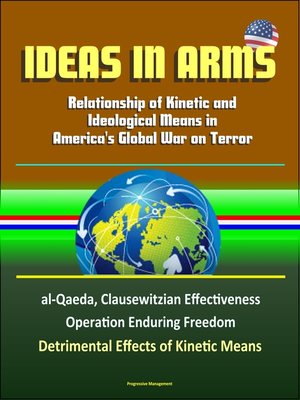Ideas in Arms
ebook ∣ Relationship of Kinetic and Ideological Means in America's Global War on Terror, al-Qaeda, Clausewitzian Effectiveness, Operation Enduring Freedom, Detrimental Effects of Kinetic Means
By Progressive Management

Sign up to save your library
With an OverDrive account, you can save your favorite libraries for at-a-glance information about availability. Find out more about OverDrive accounts.
Find this title in Libby, the library reading app by OverDrive.



Search for a digital library with this title
Title found at these libraries:
| Library Name | Distance |
|---|---|
| Loading... |
This excellent report, professionally converted for accurate flowing-text e-book format reproduction, claims that the inability of the United States to achieve its stated political objectives in its global war on terror (GWOT) reflects its flawed kinetic-centric military strategy. This study erects a framework of effectiveness utilizing Clausewitzian principles to judge military strategy. By considering the expressed political objectives of the GWOT, the centers of gravity (COG) that military strategy should target within this struggle, and the GWOT's placement along a Clausewitzian continuum of violence, this paper evaluates US military efforts in Operation Enduring Freedom (OEF) through the perspective of two opposing models. First, the paper presents a kinetic model founded in America's historical implementation of its military arm that emphasizes physical effects. Second, it constructs a nonkinetic model comprised of the primarily psychological components of the nation's informational capabilities. Examining actions in OEF through these two lenses reveals the institutional tension the US military experienced as it sought to leverage the relevant COG.
Stemming from the preeminence of ideology among the COGs of GWOT, the paper finds that the US military and civilian leadership came to recognize the detrimental effects of its continued emphasis upon kinetic means in OEF. As a thesis and antithesis conflict in a Hegelian, dialectic fashion, the US military arrived at a synthesis for its operations in Afghanistan. Acknowledging the need to elevate nonkinetic campaigns as the primary effort in OEF, US military operations began to stress actions directed at the COG of ideology. The author concludes that although the ultimate outcome of the GWOT remains to be determined, positive institutional experiences such as the provincial reconstruction team (PRT) concept need to be preserved, while significant national public diplomacy reform must occur.
CHAPTER 1 - THE TIMELINESS OF TIMELESSNESS * CHAPTER 2 - CLAUSEWITZIAN EFFECTIVENESS * CHAPTER 3 - THE KINETIC MODEL AND ITS PREVALENCE * CHAPTER 4 - THE NONKINETIC MODEL * CHAPTER 5 - OPERATION ENDURING FREEDOM: THE MODELS APPLIED * CHAPTER 6 - CONCLUSION * AL-QAEDA BACKGROUND







